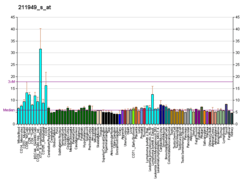Nucleolar phosphoprotein p130
Nucleolar phosphoprotein p130 is a protein that in humans is encoded by the NOLC1 gene.[3][4][5]
Interactions
Nucleolar phosphoprotein p130 has been shown to interact with coilin[6] and CEBPB.[7]
gollark: <:chips:453465151132139521> <:chips:453465151132139521> <:chips:453465151132139521> <:chips:453465151132139521> <:chips:453465151132139521> <:chips:453465151132139521> <:chips:453465151132139521> <:chips:453465151132139521> <:chips:453465151132139521> <:chips:453465151132139521> <:chips:453465151132139521> <:chips:453465151132139521> <:chips:453465151132139521> <:chips:453465151132139521> <:chips:453465151132139521> <:chips:453465151132139521> <:chips:453465151132139521> <:chips:453465151132139521> <:chips:453465151132139521> <:chips:453465151132139521> <:chips:453465151132139521> <:chips:453465151132139521> <:chips:453465151132139521> <:chips:453465151132139521>
gollark: <:chips:453465151132139521> <:chips:453465151132139521> <:chips:453465151132139521> <:chips:453465151132139521> <:chips:453465151132139521> <:chips:453465151132139521> <:chips:453465151132139521> <:chips:453465151132139521> <:chips:453465151132139521> <:chips:453465151132139521> <:chips:453465151132139521> <:chips:453465151132139521> <:chips:453465151132139521> <:chips:453465151132139521> <:chips:453465151132139521> <:chips:453465151132139521> <:chips:453465151132139521> <:chips:453465151132139521> <:chips:453465151132139521> <:chips:453465151132139521> <:chips:453465151132139521> <:chips:453465151132139521> <:chips:453465151132139521> <:chips:453465151132139521>
gollark: <:chips:453465151132139521> <:chips:453465151132139521> <:chips:453465151132139521> <:chips:453465151132139521> <:chips:453465151132139521> <:chips:453465151132139521> <:chips:453465151132139521> <:chips:453465151132139521> <:chips:453465151132139521> <:chips:453465151132139521> <:chips:453465151132139521> <:chips:453465151132139521> <:chips:453465151132139521> <:chips:453465151132139521> <:chips:453465151132139521> <:chips:453465151132139521> <:chips:453465151132139521> <:chips:453465151132139521> <:chips:453465151132139521> <:chips:453465151132139521> <:chips:453465151132139521> <:chips:453465151132139521> <:chips:453465151132139521> <:chips:453465151132139521>
gollark: <:chips:453465151132139521> <:chips:453465151132139521> <:chips:453465151132139521> <:chips:453465151132139521> <:chips:453465151132139521> <:chips:453465151132139521> <:chips:453465151132139521> <:chips:453465151132139521> <:chips:453465151132139521> <:chips:453465151132139521> <:chips:453465151132139521> <:chips:453465151132139521> <:chips:453465151132139521> <:chips:453465151132139521> <:chips:453465151132139521> <:chips:453465151132139521> <:chips:453465151132139521> <:chips:453465151132139521> <:chips:453465151132139521> <:chips:453465151132139521> <:chips:453465151132139521> <:chips:453465151132139521> <:chips:453465151132139521> <:chips:453465151132139521>
gollark: <:chips:453465151132139521> <:chips:453465151132139521> <:chips:453465151132139521> <:chips:453465151132139521> <:chips:453465151132139521> <:chips:453465151132139521> <:chips:453465151132139521> <:chips:453465151132139521> <:chips:453465151132139521> <:chips:453465151132139521> <:chips:453465151132139521> <:chips:453465151132139521> <:chips:453465151132139521> <:chips:453465151132139521> <:chips:453465151132139521> <:chips:453465151132139521> <:chips:453465151132139521> <:chips:453465151132139521> <:chips:453465151132139521> <:chips:453465151132139521> <:chips:453465151132139521> <:chips:453465151132139521> <:chips:453465151132139521> <:chips:453465151132139521>
References
- GRCh38: Ensembl release 89: ENSG00000166197 - Ensembl, May 2017
- "Human PubMed Reference:". National Center for Biotechnology Information, U.S. National Library of Medicine.
- Pai CY, Chen HK, Sheu HL, Yeh NH (Oct 1995). "Cell-cycle-dependent alterations of a highly phosphorylated nucleolar protein p130 are associated with nucleologenesis". J Cell Sci. 108. ( Pt 5): 1911–20. PMID 7657714.
- Chen HK, Pai CY, Huang JY, Yeh NH (Jan 2000). "Human Nopp140, which interacts with RNA polymerase I: implications for rRNA gene transcription and nucleolar structural organization". Mol Cell Biol. 19 (12): 8536–46. doi:10.1128/MCB.19.12.8536. PMC 84972. PMID 10567578.
- "Entrez Gene: NOLC1 nucleolar and coiled-body phosphoprotein 1".
- Isaac, C; Yang Y; Meier U T (Jul 1998). "Nopp140 functions as a molecular link between the nucleolus and the coiled bodies". J. Cell Biol. 142 (2): 319–29. doi:10.1083/jcb.142.2.319. ISSN 0021-9525. PMC 2133063. PMID 9679133.
- Miau, L H; Chang C J; Shen B J; Tsai W H; Lee S C (Apr 1998). "Identification of heterogeneous nuclear ribonucleoprotein K (hnRNP K) as a repressor of C/EBPbeta-mediated gene activation". J. Biol. Chem. 273 (17): 10784–91. doi:10.1074/jbc.273.17.10784. ISSN 0021-9258. PMID 9553145.
Further reading
- Nomura N, Miyajima N, Sazuka T, et al. (1995). "Prediction of the coding sequences of unidentified human genes. I. The coding sequences of 40 new genes (KIAA0001-KIAA0040) deduced by analysis of randomly sampled cDNA clones from human immature myeloid cell line KG-1". DNA Res. 1 (1): 27–35. doi:10.1093/dnares/1.1.27. PMID 7584026.
- Nomura N, Miyajima N, Sazuka T, et al. (1995). "Prediction of the coding sequences of unidentified human genes. I. The coding sequences of 40 new genes (KIAA0001-KIAA0040) deduced by analysis of randomly sampled cDNA clones from human immature myeloid cell line KG-1 (supplement)". DNA Res. 1 (1): 47–56. doi:10.1093/dnares/1.1.47. PMID 7584028.
- Maruyama K, Sugano S (1994). "Oligo-capping: a simple method to replace the cap structure of eukaryotic mRNAs with oligoribonucleotides". Gene. 138 (1–2): 171–4. doi:10.1016/0378-1119(94)90802-8. PMID 8125298.
- Pai CY, Yeh NH (1996). "Cell proliferation-dependent expression of two isoforms of the nucleolar phosphoprotein p130". Biochem. Biophys. Res. Commun. 221 (3): 581–7. doi:10.1006/bbrc.1996.0639. PMID 8630004.
- Miau LH, Chang CJ, Tsai WH, Lee SC (1997). "Identification and characterization of a nucleolar phosphoprotein, Nopp140, as a transcription factor". Mol. Cell. Biol. 17 (1): 230–9. doi:10.1128/MCB.17.1.230. PMC 231747. PMID 8972203.
- Li D, Meier UT, Dobrowolska G, Krebs EG (1997). "Specific interaction between casein kinase 2 and the nucleolar protein Nopp140". J. Biol. Chem. 272 (6): 3773–9. doi:10.1074/jbc.272.6.3773. PMID 9013635.
- Chen HK, Yeh NH (1997). "The nucleolar phosphoprotein P130 is a GTPase/ATPase with intrinsic property to form large complexes triggered by F- and Mg2+". Biochem. Biophys. Res. Commun. 230 (2): 370–5. doi:10.1006/bbrc.1996.5966. PMID 9016786.
- Suzuki Y, Yoshitomo-Nakagawa K, Maruyama K, et al. (1997). "Construction and characterization of a full length-enriched and a 5'-end-enriched cDNA library". Gene. 200 (1–2): 149–56. doi:10.1016/S0378-1119(97)00411-3. PMID 9373149.
- Miau LH, Chang CJ, Shen BJ, et al. (1998). "Identification of heterogeneous nuclear ribonucleoprotein K (hnRNP K) as a repressor of C/EBPbeta-mediated gene activation". J. Biol. Chem. 273 (17): 10784–91. doi:10.1074/jbc.273.17.10784. PMID 9553145.
- Isaac C, Yang Y, Meier UT (1998). "Nopp140 functions as a molecular link between the nucleolus and the coiled bodies". J. Cell Biol. 142 (2): 319–29. doi:10.1083/jcb.142.2.319. PMC 2133063. PMID 9679133.
- Blanchette P, Gilchrist CA, Baker RT, Gray DA (2001). "Association of UNP, a ubiquitin-specific protease, with the pocket proteins pRb, p107 and p130". Oncogene. 20 (39): 5533–7. doi:10.1038/sj.onc.1204823. PMID 11571651.
- Chiu CM, Tsay YG, Chang CJ, Lee SC (2002). "Nopp140 is a mediator of the protein kinase A signaling pathway that activates the acute phase response alpha1-acid glycoprotein gene". J. Biol. Chem. 277 (42): 39102–11. doi:10.1074/jbc.M205915200. PMID 12167624.
- Wang C, Query CC, Meier UT (2003). "Immunopurified small nucleolar ribonucleoprotein particles pseudouridylate rRNA independently of their association with phosphorylated Nopp140". Mol. Cell. Biol. 22 (24): 8457–66. doi:10.1128/MCB.22.24.8457-8466.2002. PMC 139890. PMID 12446766.
- Strausberg RL, Feingold EA, Grouse LH, et al. (2003). "Generation and initial analysis of more than 15,000 full-length human and mouse cDNA sequences". Proc. Natl. Acad. Sci. U.S.A. 99 (26): 16899–903. Bibcode:2002PNAS...9916899M. doi:10.1073/pnas.242603899. PMC 139241. PMID 12477932.
- Ota T, Suzuki Y, Nishikawa T, et al. (2004). "Complete sequencing and characterization of 21,243 full-length human cDNAs". Nat. Genet. 36 (1): 40–5. doi:10.1038/ng1285. PMID 14702039.
- Brill LM, Salomon AR, Ficarro SB, et al. (2004). "Robust phosphoproteomic profiling of tyrosine phosphorylation sites from human T cells using immobilized metal affinity chromatography and tandem mass spectrometry". Anal. Chem. 76 (10): 2763–72. doi:10.1021/ac035352d. PMID 15144186.
- Brandenberger R, Wei H, Zhang S, et al. (2005). "Transcriptome characterization elucidates signaling networks that control human ES cell growth and differentiation". Nat. Biotechnol. 22 (6): 707–16. doi:10.1038/nbt971. PMID 15146197.
- Beausoleil SA, Jedrychowski M, Schwartz D, et al. (2004). "Large-scale characterization of HeLa cell nuclear phosphoproteins". Proc. Natl. Acad. Sci. U.S.A. 101 (33): 12130–5. Bibcode:2004PNAS..10112130B. doi:10.1073/pnas.0404720101. PMC 514446. PMID 15302935.
This article is issued from Wikipedia. The text is licensed under Creative Commons - Attribution - Sharealike. Additional terms may apply for the media files.




